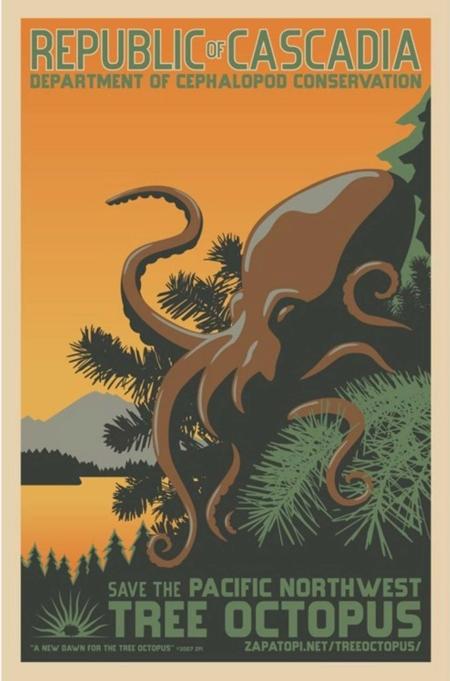Truth or consequences
Teachers, alert your students: The Pacific Northwest tree octopus needs our help! This rare and elusive species, native to the temperate rainforests of the Olympic Peninsula near Seattle, has reached critically low reproduction levels.
This urgent appeal comes from the informative, entertaining and completely fabricated “Help Save the Endangered Pacific Northwest Tree Octopus From Extinction” website. With its research citations, educational resources and FAQ — which informs us that the creature’s scientific name is octopus paxarbolis — the site has been used since its creation in 1998 as an example of how easily students can be fooled by convincing media.
We can teach students to become critical consumers of information by teaching them media literacy — or more appropriately, information literacy. The goal is not just to help students distinguish between factual and fictional content but to encourage them to think critically about all the information they encounter — whether the source is a classroom textbook, a CNN program or a TikTok video.
“Media literacy is literacy,” wrote Mary Kate Lonergan, an 8th-grade social studies teacher in Central New York, in a column for PBS.org. “Media literacy doesn’t need to be ‘another thing’ to teach … I see it as another way to teach.”
In January, our neighbor New Jersey became the first state to mandate the inclusion of media literacy in K-12 curricula. Legislation signed by Gov. Phil Murphy requires that students learn how to identify various types of sources; distinguish among facts, points of view and opinions; and consider “the ethical production of information.”
The bill also strongly recommended putting the development of information literacy curricula in the hands of school library media specialists, with good reason: In New York, for instance, librarians have been using the Empire State Information Fluency Continuum (ESIFC) to teach information literacy skills since 2009.
“The concepts we’re teaching, like looking for citations of sources and identifying bias, are not new,” said Vincent Hyland, a school library media specialist in the city Department of Education’s Office of Library Services. “Digital fluency is about having a set of tools and skills that allow students to be responsible and ethical consumers of information when they’re ‘out in the wild’ of the internet.”
In other words, lessons like comparing and contrasting different texts, considering narrators’ points of view and supporting arguments with text evidence have long been part of a well-rounded curriculum. But by sharpening their focus on information literacy, teachers can ensure students are ready to take those lessons out of the classroom and onto the internet, television screens and other forms of new media.
One way students can build information literacy skills is by practicing “lateral reading,” or the process of investigating the source of information before deciding whether to trust what the source has to say.
“Minimum-wage.org is a website that looks unbiased,” Hyland explained. “It’s got graphs and charts, it ends in .org — it passes the litmus test that I was taught in school. But when you do lateral reading, you find out that it’s produced by a deeply conservative institution opposed to minimum wage increases.”
Another strategy is to help students hone their sense of skepticism by developing their skill at asking questions.
“Students sometimes struggle with asking questions because they are so used to providing answers,” said Lonergan. “A media-literate person is inquisitive and curious about the media they consume.”
Shawn Fisch, a civics teacher and a UFT Teacher Center coach at Long Island City HS in Queens, said he teaches students to “follow the money” and consider who is funding an information source.
“Everything is made for a reason: entertainment, education or profit,” he said. “What’s the intention behind the design?”
It’s also important for teachers to “treat students like the content creators they are,” Hyland noted. If you’ve ever scrolled through a teen’s Instagram feed, you’re probably aware that students produce as much media as they consume.
“On the internet, there’s a reciprocal relationship between user and creator,” said Hyland. “We need to teach students to be responsible in their production of content.”
If you ask students to produce a TikTok video or a series of social media posts for class in which they cite their sources, they’ll be nudged to consider citing sources in their own social media and begin to notice the same ethical behavior — or the lack thereof — in their feeds.
“Our students understand what plagiarism is, but the examples we use in the classroom don’t always transfer to the real world,” said Fisch. After all, replicating dance moves on TikTok, sampling music and spoofing movies are ubiquitous trends in pop culture.
“People can and do manipulate information,” said Hyland. “The best thing we can ask for is for students to be thoughtful inquirers, to always ask questions about what’s put in front of them.”
If you’re tackling information literacy in your own classroom, consider a lesson on the fictional Pacific Northwest tree octopus: Despite ongoing threats to its habitat, the cephalopod has managed to captivate and galvanize students for 25 years.

